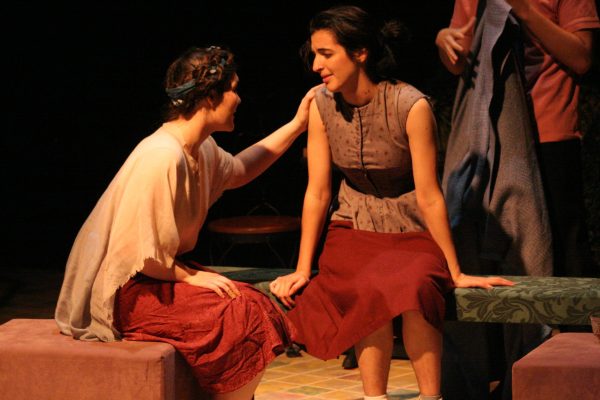Season Two of Snicket Just as Grimly Humorous
Editor’s Note: This article contains spoilers for season two of the Netflix series A Series of Unfortunate Events.
It has been 14 months since we left the Baudelaire orphans anxiously clustered on a bench outside the principal’s office at Prufrock Preparatory School at the end of season one of A Series of Unfortunate Events. The second season, which premiered March 30 on Netflix, opens with the three Baudelaires sitting on the same bench, equally as nervous as before — but Sunny is inexplicably at least a year older. They’re promptly installed in the latest of their temporary homes and, because it is a boarding school and presumably a safer space, we begin this season’s journey with slightly more hope than we ended the last. This hope, however, is misplaced.
Over the course of season two’s 10 episodes — which mirror books five to nine of Daniel Handler’s middle-grade series, from The Austere Academy to The Carnivorous Carnival, in pairs — we follow Violet, Klaus, and Sunny as they continuing running from the nefarious Count Olaf and his gang of oddly endearing henchpeople. From jogging in circles for hours at night at the academy, falling down elevator shafts from a penthouse, and being accused of committing murder to setting a hospital on fire and nearly being fed to lions, the events of the Baudelaires’ lives only become more heartbreaking as they discover more about their parents’ involvement with the mysterious organization known as VFD.
This season brings several new characters into play in the form of both competent and slightly inept members of the VFD trying to help the children and dastardly villains doing their best to steal the Baudelaire fortune — or, strangely, a precious sugar bowl. Highlights include Nathan Fillion as the dashing (and later dead) Jacques Snicket; Kitana Turnbull as a very pink, very irritating Carmelita Spats; and Usman Ally as the surprisingly sympathetic Hook-Handed Man. Malina Weissman, Louis Hynes, and Presley Smith — who play Violet, Klaus, and Sunny, respectively — do an excellent job of building on their character development and bringing more nuance and depth to their performances in season two.
Each episode is drenched in dramatic irony, as the ever-delightful yet dolefully morbid Lemony Snicket (Patrick Warburton, well-known by ’90s kids for voicing Kronk in Disney’s The Emperor’s New Groove) pops up intermittently throughout each episode to warn us of tragic events to come. This season also features plenty of flashbacks about Snicket’s own involvement in the VFD, including a love affair with the mysterious Beatrice to whom he continuously writes poetic yet depressing notes to introduce each episode.
Yet, though forewarned, we’re really only along for the ride as Klaus, Violet, and Sunny — despite their desperate desire for answers and a safe home — are continuously outsmarted by Count Olaf through means so ridiculous that even he’s surprised that they work. This is one of the series’ weaker plot points, as the adults’ obliviousness and complacency in the face of Olaf’s increasing notoriety become less and less believable. This can get frustrating, as by the end of the season we are still left with more questions than answers, though we have finally discovered what VFD stands for — Volunteer Fire Department — and its mission to put out both real and metaphorical “fires” around the world. The eye tattoo, commonly used to reveal Count Olaf in disguise, turns out to be the organization’s identifying symbol. Unfortunately, we only realize this when Jacques Snicket is misrepresented as Count Olaf and killed with a crowbar by the real Count Olaf in a crow…bar.
Wordplay and situational irony like this are commonplace and provide witty moments of levity in an otherwise dark and twisted tale. This season’s plot creates an effective emotional rollercoaster; it peaks at highs like the Baudelaires’ friendship and budding crushes on Isadora and Duncan Quagmire, but reaches new morale lows as librarian-turned-VFD-superspy Olivia Caliban is fed to lions shortly after Jacques Snicket’s untimely and unfair death. It is clear that despite any tentative optimistic moments, the lives of the Baudelaire orphans can always get worse.
Though the episodes in this season average about a 45-minute runtime, the season as a whole passes quickly, especially as the Baudelaires spend two episodes resolving each location’s main storyline — and if you’re like us and binge watch, it’ll only take you three days to get through the whole thing. While high stakes and the characters’ quick wits create a fast-paced atmosphere, it often feels rushed; the Baudelaires leave a location just as they and the audience are beginning to get comfortable. If the writers did this intentionally to maintain a connection between audience and characters, then bravo. If not, it disrupts the flow of the narrative and leaves the audience feeling slightly off-balance until the season culminates in a real doozy of a cliffhanger.
Consistent highlights throughout the season include the vibrant, flashy color found in episodes like The Carnivorous Carnival and The Vile Village, which are a high contrast to the heavy use of gray-toned scenery in, for one, The Hostile Hospital. Musically, the show’s theme song, with vocals by Neil Patrick Harris, is as creepily humorous as ever, a fitting complement to a series that is just that.
Despite repeated warnings to the contrary, we didn’t “look away” from season two of A Series of Unfortunate Events. You shouldn’t either.







